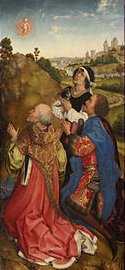Revelation of the Magi. Trans. & ed. Brent Landau. New York: Harper, 2010. E-book.
Revelation of the Magi is from an eighth-century Syriac (Aramaic) manuscript that had never been translated into English until Dr. Landau did it. The book is therefore subtitled The Lost Tale of the Wise Men’s Journey to Bethlehem.
Even though this is being posted around Three Kings’ Day or Epiphany, these are not your typical three kings. Of course, the Bible does not actually tell us how many wise men there were. Generally people portray three of them because the Bible mentions three gifts of gold, frankincense, and myrrh.
While the Bible only says that they came from the East to Judea, usually it is assumed that they were Persian because the Septuagint and other Jewish writings in Greek use the term magi to describe the Mandarin class royal advisors to the Persian kings.
The twelve wise men in this tale come from the far East. Their land of Shir is said to border the Ocean. (Yes, educated people in the Middle Ages understood the world was round, even if they did not know about the continent between East Asia and Western Europe.) The writer tells us that they believed in a supreme God even though they did not have knowledge of the Hebrew Scriptures, perhaps like the Chinese who traditionally acknowledged the King of Heaven.
In this tale the star was not a planet, nova, comet, or anything like that. It was a supernatural star that only the wise men could see. Sometimes the star would contain or turn into the Christ Child who would speak to them. Not only does the child tell them how to get to Bethlehem, but he shares lots of orthodox teaching about the Messiah. Parts echo the first chapter of the Gospel of John or the Athanasian Creed.
Painting by Rogier van Weyden c. 1450 showing child in star with Three Magi. Altarpiece, Middleburg, Belgium. Photo by Sailko, Wikimedia Commons.
The wise men do stop in Jerusalem and consult with Herod and the city elders. Nowhere does it mention what the gifts they gave were other than to say that they came from a secret cave in their homeland.
The story itself is straight from the Middle Ages. The various apparitions, magic caves, hidden treasures, magical foods and fountains that show up reminded this reader of various King Arthur stories, especially ones about the search for the Holy Grail, with some Arabian Nights thrown in. The theology is consciously quite orthodox. Even though it varies significantly from the Gospel account and comes across as a work of fiction, it does not have the doctrines of any of the Gnostic writings.
The translator has an extensive introduction and detailed footnotes. He tells of the provenance of the story and how it compares to similar Medieval tales from Ireland to Arabia (there used to be Christians there). He is a scholar of Biblical languages, but he does tell the reader up front that he does not believe Matthew’s account of the magi, either.
He also notes a number of Medieval and Renaissance works of art portraying the wise men that include such things as a cave, a fountain, or a child in a star which would indicate that the Revelation of the Magi tale had traction in some form through Christendom. We will not get particular insight on the magi from reading this , but it is an interesting historical artifact.
